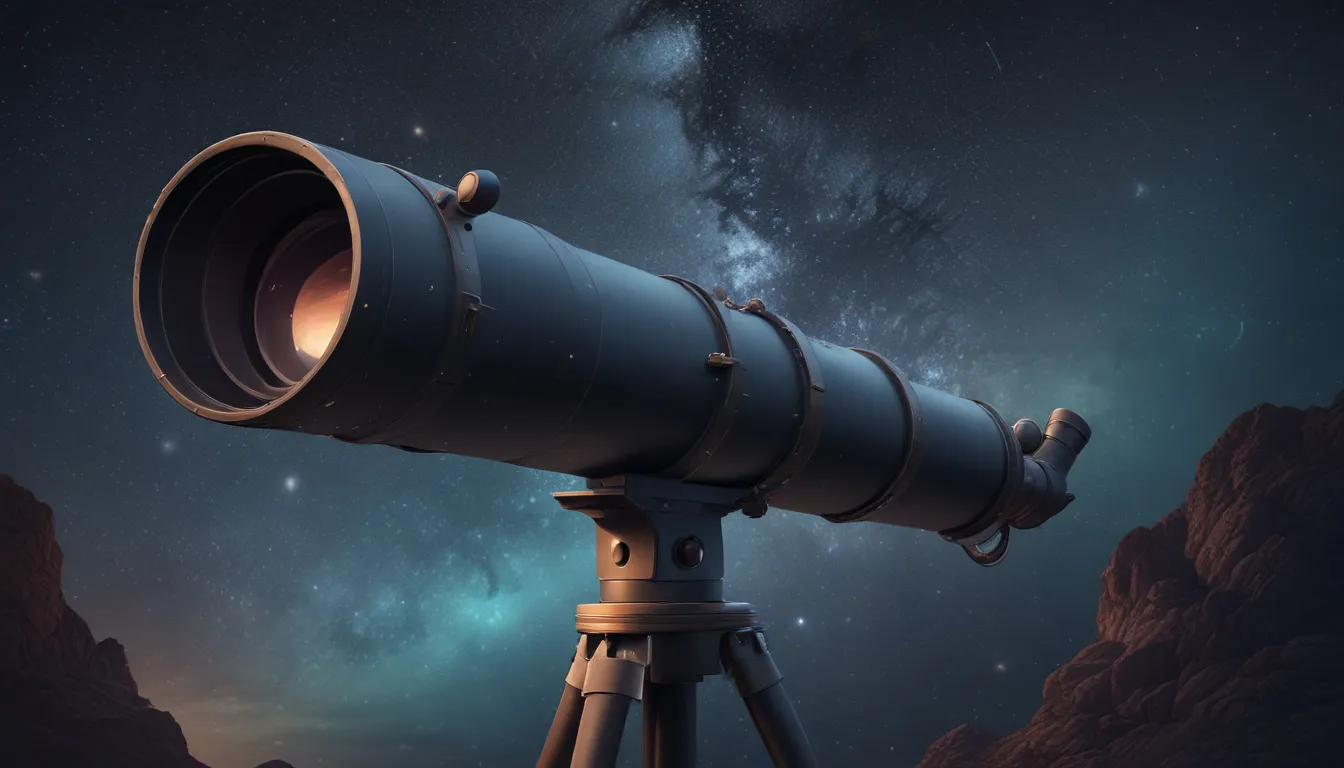A Note About Images: The images used in our articles are for illustration purposes only and may not exactly match the content. They are meant to engage readers, but the text should be relied upon for accurate information.
Telescopes have always been our windows to the vast and mesmerizing cosmos, granting us a glimpse into distant galaxies, twinkling stars, and captivating celestial phenomena. In this article, we will embark on an enlightening journey as we uncover 15 intriguing facts about telescopes. From their humble beginnings to the cutting-edge advancements of today, these incredible instruments have continuously expanded our knowledge and fueled our fascination with the universe.
The Evolution of Telescopes
Telescopes have a rich history that dates back to the early 17th century when Dutch mathematician and astronomer, Hans Lippershey, invented the first telescope. His creation consisted of a convex objective lens and a concave eyepiece, allowing for magnified views of distant objects. This invention laid the groundwork for the telescopes we use today to explore the mysteries of the cosmos.
Galileo Galilei: Telescope Pioneer
Italian scientist Galileo Galilei made significant contributions to telescope technology in the early 1600s. Galileo’s telescopes featured improved magnification and clarity, enabling him to make groundbreaking observations of celestial bodies such as the Moon’s craters, Jupiter’s moons, and Saturn’s rings. His pioneering work revolutionized our understanding of the universe.
Unveiling the Cosmos with Refracting Telescopes
Refracting telescopes utilize lenses to gather and focus light, allowing us to observe both celestial and terrestrial objects. These telescopes use an objective lens to capture incoming light and an eyepiece lens to magnify the image for observation. Refracting telescopes have played a vital role in revealing the beauty of the cosmos to astronomers and stargazers alike.
Reflecting Telescopes: A Unique Perspective
Reflecting telescopes employ mirrors to gather and focus light, offering a distinct view of the universe. The primary mirror collects incoming light and reflects it to a secondary mirror, which then directs the light to an eyepiece or detector. These telescopes have provided astronomers with valuable insights into the secrets of the cosmos.
The World’s Largest Telescope: Gran Telescopio Canarias
The Gran Telescopio Canarias (GTC), located in Spain’s Canary Islands, holds the prestigious title of the world’s largest single-aperture optical telescope. With a mirror diameter of 10.4 meters (34 feet), the GTC provides astronomers with an exceptional tool for studying the universe and unraveling its mysteries.
Radio Telescopes: Listening to the Celestial Whispers
Radio telescopes are essential tools for studying celestial objects and phenomena by detecting radio waves emitted from space. These telescopes capture and amplify radio signals, allowing scientists to analyze cosmic microwave background radiation, pulsars, quasars, and more. Radio telescopes play a crucial role in our exploration of the universe.
The Revolutionary Hubble Space Telescope
Launched into space in 1990, the Hubble Space Telescope (HST) has transformed our understanding of the cosmos. The HST has captured breathtaking images and made groundbreaking discoveries, such as determining the age of the universe, discovering dark energy, and studying galaxy formation. This visionary observatory continues to inspire awe and curiosity.
Adaptive Optics: Enhancing Astronomical Vision
Adaptive optics is a technology used to counteract the blurring effects of Earth’s atmosphere on telescope observations. By analyzing atmospheric turbulence and making real-time adjustments to the telescope’s mirror, adaptive optics enhance image quality and provide clearer views of celestial objects. This technology has revolutionized astronomical research.
Space vs. Earth-based Telescopes
Space-based telescopes, like the Hubble Space Telescope, are positioned beyond Earth’s atmosphere, enabling them to capture images with unparalleled clarity. Earth-based telescopes, while subject to atmospheric distortion, are easier to maintain and upgrade, allowing for ongoing scientific research. Both types of telescopes contribute to our exploration of the universe.
Exploring the Invisible with Infrared Telescopes
Infrared telescopes detect infrared radiation emitted by celestial objects, unveiling information that is invisible to the human eye. By studying infrared light, astronomers can investigate phenomena such as star formation, planetary atmospheres, and distant galaxies. Infrared telescopes provide valuable insights into the cosmic landscape.
Peering into the High-Energy Universe with X-ray Telescopes
X-ray telescopes detect high-energy X-ray radiation, offering critical insights into phenomena like black holes, neutron stars, and supernovae. These telescopes utilize specialized mirrors and detectors to capture and analyze X-rays emitted by celestial objects, shedding light on the mysteries of the high-energy universe.
Telescopes in Space: Beyond Earth’s Boundaries
Telescopes placed in space have a unique advantage as they are not affected by Earth’s atmosphere, allowing for clearer observations. Space telescopes, such as the Chandra X-ray Observatory and the Spitzer Space Telescope, have opened new avenues for exploring the enigmatic cosmos and expanding our cosmic knowledge.
Antarctic Adventures: Telescopes in the Ice
Antarctica serves as an ideal location for telescopes due to its stable atmosphere, low humidity, and extended periods of darkness. Telescopes, such as the South Pole Telescope, leverage Antarctica’s extreme conditions to study cosmic microwave background radiation and delve into the mysteries of the early universe. Antarctica provides a chilling yet captivating backdrop for astronomical research.
The James Webb Space Telescope: A Glimpse into the Past
Scheduled for launch in 2021, the James Webb Space Telescope (JWST) is poised to become the most powerful space telescope ever built. The JWST will observe the universe in infrared light, enabling scientists to explore the first galaxies, study exoplanet atmospheres, and unravel the cosmic origins of our existence. This revolutionary telescope promises to unlock new realms of discovery.
Citizen Science and Telescopes: Bridging Enthusiasts and Professionals
Citizen science projects, such as the Zooniverse platform, engage enthusiasts in contributing to real scientific research using telescope data. By harnessing the collective power of amateur astronomers worldwide, these projects facilitate the discovery of new celestial objects and enable scientific breakthroughs. Citizen science bridges the gap between amateurs and professionals, fostering collaboration and innovation in astronomy.
Embracing the Wonders of the Universe
Telescopes have played a pivotal role in expanding our knowledge of the universe, revealing its splendors, and igniting our curiosity. From the groundbreaking discoveries of Galileo Galilei to the visionary capabilities of space-based observatories like the Hubble Space Telescope, telescopes have reshaped our perception of the cosmos. As technology continues to advance, telescopes will undoubtedly lead us to new insights and awe-inspiring revelations.
Exploring the Universe: Frequently Asked Questions
What is the most famous telescope in the world?
The Hubble Space Telescope is widely acclaimed as the most famous telescope due to its stunning images and groundbreaking discoveries.
How do telescopes work?
Telescopes function by gathering and focusing light, enabling us to observe distant objects with enhanced clarity and magnification.
Can telescopes see planets?
Yes, telescopes can observe planets within our solar system and beyond, providing insights into their surface features, moons, and atmospheric conditions.
Are telescopes only used by professional astronomers?
No, telescopes are also utilized by amateur astronomers, stargazers, and enthusiasts who enjoy observing celestial objects as a hobby.
Can telescopes see the past?
Telescopes indirectly allow us to peer into the past by capturing light that has traveled vast distances before reaching Earth. This light reveals objects as they existed in the past, offering a glimpse into history.
Our commitment to delivering trustworthy and engaging content is at the core of what we do. Each fact we share is contributed by real users like you, bringing a wealth of diverse insights and information. Our dedicated editors meticulously review each submission to ensure the highest standards of accuracy and reliability. Trust in our dedication to quality and authenticity as you explore and learn with us.





